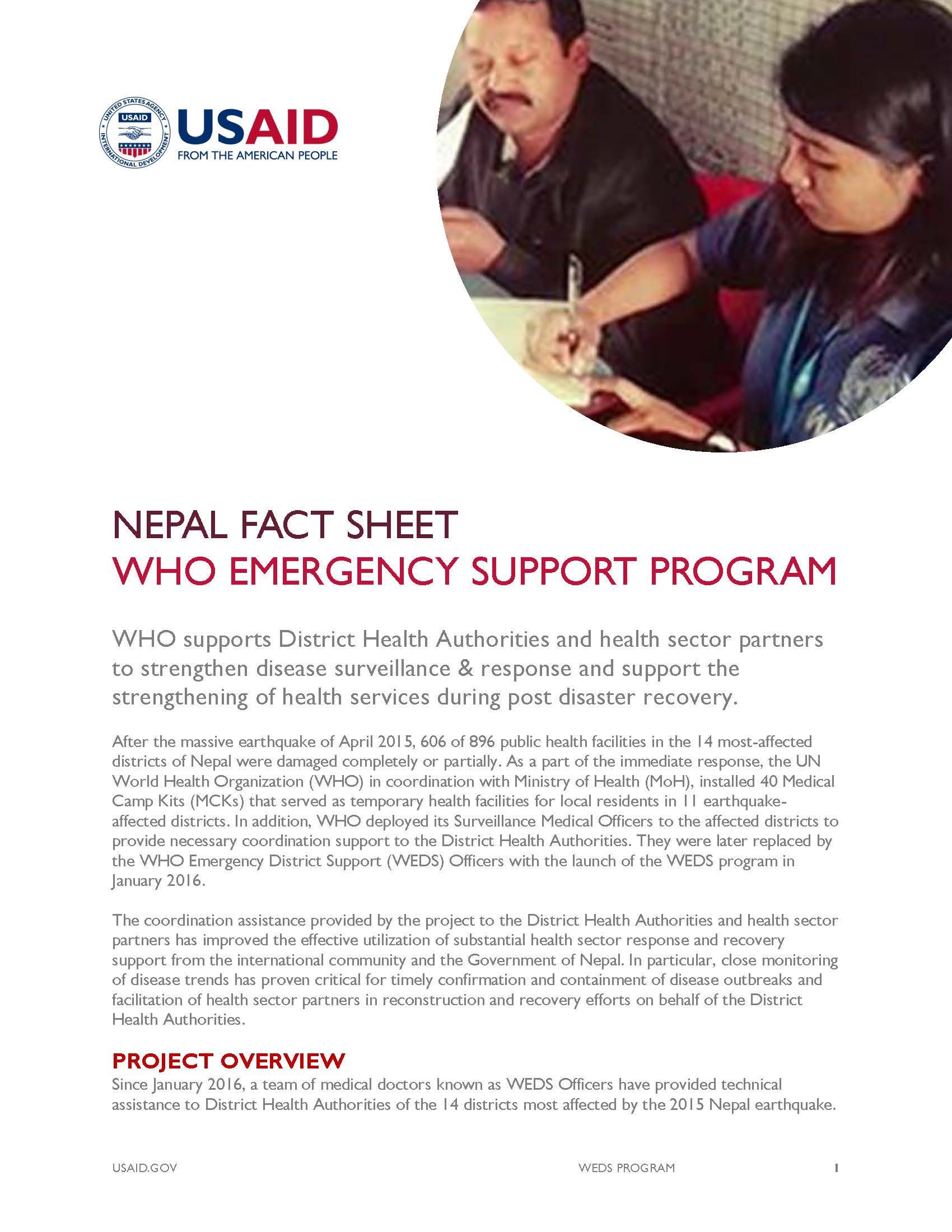WHO supports District Health Authorities and health sector partners to strengthen disease surveillance & response and support the strengthening of health services during post disaster recovery.
Fact Sheet: WHO EMERGENCY SUPPORT PROGRAM ![]() (pdf - 120k)
(pdf - 120k)
After the massive earthquake of April 2015, 606 of 896 public health facilities in the 14 most-affected districts of Nepal were damaged completely or partially. As a part of the immediate response, the UN World Health Organization (WHO) in coordination with Ministry of Health (MoH), installed 40 Medical Camp Kits (MCKs) that served as temporary health facilities for local residents in 11 earthquake-affected districts. In addition, WHO deployed its Surveillance Medical Officers to the affected districts to provide necessary coordination support to the District Health Authorities. They were later replaced by the WHO Emergency District Support (WEDS) Officers with the launch of the WEDS program in January 2016.
The coordination assistance provided by the project to the District Health Authorities and health sector partners has improved the effective utilization of substantial health sector response and recovery support from the international community and the Government of Nepal. In particular, close monitoring of disease trends has proven critical for timely confirmation and containment of disease outbreaks and facilitation of health sector partners in reconstruction and recovery efforts on behalf of the District Health Authorities.
PROJECT OVERVIEW
Since January 2016, a team of medical doctors known as WEDS Officers have provided technical assistance to District Health Authorities of the 14 districts most affected by the 2015 Nepal earthquake. USAID’s Office of U.S. Foreign Disaster Assistance (USAID/OFDA) has supported this intervention since February 2016. Project objectives include strengthening disease surveillance and response, and supporting re-strengthening of health services in affected health facilities
PROJECT ACTIVITIES
- Supporting the Early Warning and Reporting System (EWARS) for outbreak-prone communicable diseases.
- Formalizing and supporting the implementation of an event-based surveillance mechanism for rapid detection of adverse health events.
- Supporting District Health Authorities to verify rumors and investigate and contain disease outbreaks.
- Monitoring the stock of essential medicines, vaccines, and emergency medical logistics with follow up on stock-out issues in coordination with District Health Authorities.
- Monitoring the delivery of health services and suggesting appropriate corrective measures where required.
- Upgrading and maintaining WHO-installed MCKs for seasonal preparedness and weather proofing.
- Undertaking timely action-learning projects aimed at risk reduction and health systems strengthening in coordination with the WCO Nepal Health Emergencies Program team in Kathmandu.
- Assisting District Health Authorities through health sector partner coordination meetings to follow up on recovery-related activities.
PLANNED RESULTS
- 33 outbreaks of infectious and non-infectious diseases investigated and contained by the District Rapid Response Teams with the active support of the WEDS Officers.
- Timeliness and completeness indicators of the EWARS improved.
- 884 monitoring visits conducted in 472 of 896 health facilities (100% of district hospitals & primary health care centers and 53% of all health posts visited).
- Health facility needs assessments conducted to prepare for the ill effects of the 2016 monsoon and the 2016 and 17 winter seasons.
- 'Supporting To Strengthen' – Helping the health worker to update the medicine stock register.
- 24 Medical Camp Kits and 7 tents of Rasuwa District Hospital repaired / upgraded during the spring 2016.
- District Health Authorities facilitated to review/update District Health Sector Contingency Plans in coordination with Epidemiology and Diseases Control Division (EDCD).
- Health camps conducted in the districts by partners jointly monitored.








Comment
Make a general inquiry or suggest an improvement.